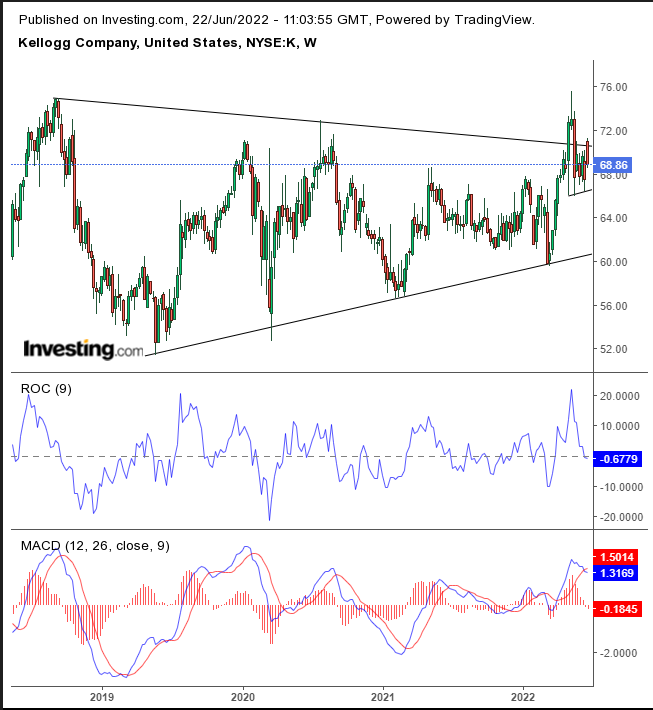Kellogg (NYSE:K) made a surprising announcement. It plans to break the business into three distinct independent companies—plant-based, cereal, and snacks—to allow each part of the business to focus on growth.
This dramatic move will extend its long-term strategy of focusing on snacks. As people increasingly eat between meals, the company bought Pringles a decade ago for $2.7 billion. Conversely, Kellogg's regular business, cereal, has stagnated as the culture turns to consumers eating on the go. It did receive a temporary boost during the coronavirus pandemic when consumers were forced to stay at home.
Will this break-up strategy help boost the stock? Well, that depends. Let's look at the chart.

The announcement increased the stock's price by 2%. While that sounds like positive price action, it's not so simple. The session's bullishness was deflated, as the stock initially surged 5%, but bears executed a counter-attack, demonstrating resistance at the May 26 high.
If the price falls below $66, it will have completed an H&S top.
Now, let's get a broader scope, and see if we can understand the context of the moves on the chart.

We now realize the significance of the daily H&S, as the price found resistance at the top of a weekly triangle, whose stop begins in 2018.
Here, we see both the Moving Average Convergence Divergence—comparing price averages of different periods—and the Rate of Change—comparing momentum—have triggered sell signals. The ROC fell below 0.
If the Daily H&S is complete, the price will retest the bottom of the weekly triangle.
Trading Strategies
Conservative traders should wait for the price to fall through the neckline and employ a 3% and a three-day (preferably with a weekend) filter to avoid a bear trap. Then, they should wait for a Return Move to retest the pattern's integrity before committing to a short position.
Moderate traders would wait for a 2%, two-day penetration and a corrective rally for a better entry, if not for confirmation.
Aggressive traders could be short now on the resistance by the pattern's shoulders and weekly triangle top. Money management is key. Here is a generic example:
Trade Sample - Aggressive Long Position
- Entry: $71
- Stop-Loss: $72
- Risk: $1
- Target:$61
- Reward: $10
- Risk-Reward Ratio: 1:10
Author's Note: This is a generic sample. The better the strategy incorporates your timing, budget, and temperament, the more successful your overall trading will be. For example, the price may not climb to $71. Some traders may prefer to short at $72 for more opportunities overall, while others prefer to trade less and only when exceptional opportunities arise. You will learn your preferences with experience. Till then, you may use our samples for educational purposes. If you focus on profit, you may end up with neither. Happy trading!
